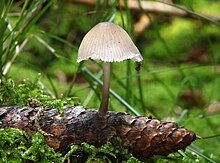Spruce cone
| Spruce cone | ||||||||||||
|---|---|---|---|---|---|---|---|---|---|---|---|---|

Spruce cone root ( Strobilurus esculentus ) |
||||||||||||
| Systematics | ||||||||||||
|
||||||||||||
| Scientific name | ||||||||||||
| Strobilurus esculentus | ||||||||||||
| ( Wulfen ) Singer |
The spruce cone or Fichtenzapfen nail sponge ( Strobilurus esculentus ) is a mushroom art from the genus of strobilurus ( Strobilurus ). Its fruiting bodies grow from October to May on spruce cones that have fallen, are often sunk into the ground or are underground.
features
Macroscopic features
The hat of the spruce-cone root is 2–4 cm wide and has a bare surface. Its color varies between gray, chocolate brown and umber . Specimens grown in the shade are much lighter in color, horn gray to almost white. However, they quickly darken when exposed to light. The lamellas are slightly crowded, wide, thin and rounded at the stem so that they are almost free. Their color ranges between white and gray. The species has a firm and tough stalk 4–10 cm above ground length, which is only thinly hollowed out inside. It is fox-red or yellow-brown in color and has a shiny surface. Its tip is usually white and sits on a 6–10 cm long, fibrous pseudo-root that z. B. crawling in the ground from a buried pine cone grows. Fruiting bodies that grow from semi-terrestrial cones are usually smaller and lighter; they have only very short false roots.
Microscopic features
The cystidia of the spruce cone root are lanceolate to bluntly spindle-shaped. They are rounded and encrusted with a wreath of large crystals. There are cheilo-, pleuro, and dermatocystids, all of which have thick walls. The hyphae septa of the species have no buckles . The trama of the lamellae has a regular structure, the cells of the cap skin are hymeniform , thus resembling the arrangement of basidia in the fruit layer .
ecology
The species occurs in all artificial or natural spruce communities, whereby the soil must have a certain amount of moisture in order to ensure the growth of the fungus. These include moors as well as clay pits, parks or banks. The geological and edaphic circumstances play only a minor role. The substrate always consists of buried or above-ground spruce cones.
The fruiting bodies of the species appear mainly between mid-October and early May; at higher altitudes they can usually only be found from the end of February. In the lowlands and hills, however, the growth of the fruiting bodies usually shifts a month forward. If the required warm, humid weather prevails, the spruce cone can also be found all year round.
distribution
The spruce cone is so far only known from Europe. There it occurs in all regions and locations with the exception of south-western Europe, the northern limit of distribution marks around the 68th parallel.
Systematics
The following varieties of the spruce cone root have been described:
- Strobilurus esculentus var. Esculentus ( Wulfen ) Singer 1962
- Strobilurus esculentus var. Griseus ( Schaeffer ) Métrod
- Strobilurus esculentus var. Montezumae Singer 1973
Species delimitation
Spruce cone helmling
Another specialist in spruce cones, which fructifies at the same time as the spruce cone, is the spruce cone helmling ( Mycena strobilicola ). However, it has a pungent smell of chlorine / swimming pool and has a bell-shaped hat even with age.
Mouse tail bugger
The mouse-tailed ruff ( Baeospora myosura ) also occurs on spruce cones . Its fruiting bodies, however, have more dense lamellae and not such a brightly colored stem. The species is also rarely found in spring, while the spruce cone often already forms a mass aspect after the snow has melted.
Pine cones
The similar looking mildness and the bitter pine cone ( Strobilurus stephanocystis or S. tenacellus ) grow on pine cones . However, the two species can easily be distinguished by their specific substrate, pine cones, from their cousins, spruce cones.
swell
literature
- German Josef Krieglsteiner (Ed.), Andreas Gminder : Die Großpilze Baden-Württemberg . Volume 3: Mushrooms. Leaf mushrooms I. Ulmer, Stuttgart 2001, ISBN 3-8001-3536-1 .
Web links
- Index Fungorum: Strobilurus. www.indexfungorum.org, 2008.
- Frank Moser: Portrait of the spruce cone carrot . On: Natur-Lexikon.com . Retrieved August 16, 2011.
- Georg Müller: Picture collection of the spruce cone root . In: picture gallery on pilzepilze.de . Retrieved August 16, 2011.
- Mushroom association of the Baden region (CH): Portrait of the spruce-cone root . On: picture gallery on pilz-baden.ch . Retrieved August 16, 2011.
Individual evidence
- ↑ a b Krieglsteiner & Gminder 2001 , p. 517.
- ↑ a b c Krieglsteiner & Gminder 2001 , p. 518.
- ↑ Index Fungorum 2008 . Retrieved August 14, 2011.


